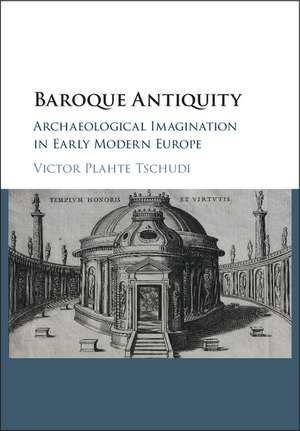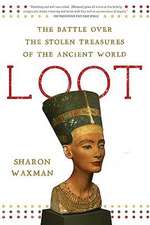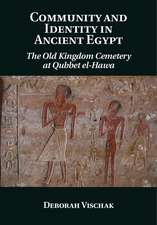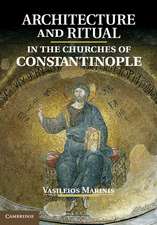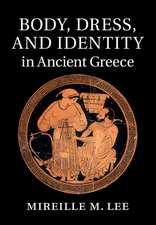Baroque Antiquity: Archaeological Imagination in Early Modern Europe
Autor Victor Plahte Tschudien Limba Engleză Hardback – 11 sep 2016
Preț: 707.41 lei
Preț vechi: 794.84 lei
-11% Nou
Puncte Express: 1061
Preț estimativ în valută:
135.36€ • 141.05$ • 112.08£
135.36€ • 141.05$ • 112.08£
Carte tipărită la comandă
Livrare economică 03-17 aprilie
Preluare comenzi: 021 569.72.76
Specificații
ISBN-13: 9781107149861
ISBN-10: 110714986X
Pagini: 320
Ilustrații: 100 b/w illus. 8 colour illus.
Dimensiuni: 188 x 262 x 20 mm
Greutate: 0.87 kg
Editura: Cambridge University Press
Colecția Cambridge University Press
Locul publicării:New York, United States
ISBN-10: 110714986X
Pagini: 320
Ilustrații: 100 b/w illus. 8 colour illus.
Dimensiuni: 188 x 262 x 20 mm
Greutate: 0.87 kg
Editura: Cambridge University Press
Colecția Cambridge University Press
Locul publicării:New York, United States
Cuprins
Introduction; 1. The archaeology of prints; 2. Custom-made Rome; 3. Moral monuments; 4. Peter versus Jupiter; 5. Father Kircher's retreats; 6. Christ in Tivoli.
Recenzii
'Tschudi has examined forty copies of Lauro for this extremely well-researched book. He has immersed himself not only in the Renaissance antiquarian texts, but also in the literature on the highly competitive Roman print industry. There are remarkable insights at every turn. … This thoughtful, elegantly written book has demonstrated that in our post-truth world scholarship should make room for Lauro too.' Joseph Connors, Renaissance Quarterly
'… Rivets the reader's attention while covering a broad swathe of ideas and history (from antiquity to the baroque), bristling with ideas and archaeological imaginings which are rich, varied, and at times pleasingly complex; a baroque complexity befitting the author's themes and dazzling critiques as well as straightforward accounts. Tschudi bestows on the reader something deeply considered, and-in the sense that he meditates on how in early modern Rome the past came to be understood in light of the baroque present (mostly seventeenth century) and how it might be retrieved-profound … I heartily advise the reader, whom I suppose to be interested in art history of the early modern period in Rome, to get this book and enjoy Tschudi's investigations and his art historical perambulations …' Vernon Hyde Minor, Journal of Jesuit Studies
'… addresses, with coruscating wit, a more challenging aspect of Lauro's handiwork: the fact that so many of his reconstructions of ancient monuments fly in the face of archaeological accuracy, not just in the details, but entirely … Tschudi introduces readers to another seventeenth-century rogue, albeit one with an imagination as epic as Piranesi's: Father Athanasius Kircher, the German refugee who spent most of his life at the Jesuit Roman College in Rome and, like Giovanni Alto before him, served as a point of reference for German visitors to the Eternal City. Kircher's reconstructions of ancient Roman monuments are sometimes as extravagantly fictitious as any caprice of Lauro's Antiquae Urbis Splendor, and sometimes, again like Lauro's, as accurate as modern scholarship could make them. The printmaker and the Jesuit savant departed from archaeological accuracy not out of ignorance, but by deliberate choice, and thereby hangs Tschudi's fascinating story.' Ingrid D. Rowland, New York Review of Books
'One of the many virtues of Victor Plahte Tschudi's book is that it takes Kircher's efforts in Christian archaeology seriously, and integrates them into a larger story: the story of what the author calls 'baroque archaeology', which flourished in Rome from around 1580 to 1680.' Anthony Grafton, London Review of Books
'Tschudi's writing is nimble and engaging, worthy of his eccentric and delightful subject(…)Tschudi's book represents a key new contribution to the literature, offering valuable insights into the complex and changing-not to say baroque-relationship between antiquarians and antiquity.' David Karmon, Future Anterior: Journal of Historic Preservation, History, Theory, and Criticism
'… Rivets the reader's attention while covering a broad swathe of ideas and history (from antiquity to the baroque), bristling with ideas and archaeological imaginings which are rich, varied, and at times pleasingly complex; a baroque complexity befitting the author's themes and dazzling critiques as well as straightforward accounts. Tschudi bestows on the reader something deeply considered, and-in the sense that he meditates on how in early modern Rome the past came to be understood in light of the baroque present (mostly seventeenth century) and how it might be retrieved-profound … I heartily advise the reader, whom I suppose to be interested in art history of the early modern period in Rome, to get this book and enjoy Tschudi's investigations and his art historical perambulations …' Vernon Hyde Minor, Journal of Jesuit Studies
'… addresses, with coruscating wit, a more challenging aspect of Lauro's handiwork: the fact that so many of his reconstructions of ancient monuments fly in the face of archaeological accuracy, not just in the details, but entirely … Tschudi introduces readers to another seventeenth-century rogue, albeit one with an imagination as epic as Piranesi's: Father Athanasius Kircher, the German refugee who spent most of his life at the Jesuit Roman College in Rome and, like Giovanni Alto before him, served as a point of reference for German visitors to the Eternal City. Kircher's reconstructions of ancient Roman monuments are sometimes as extravagantly fictitious as any caprice of Lauro's Antiquae Urbis Splendor, and sometimes, again like Lauro's, as accurate as modern scholarship could make them. The printmaker and the Jesuit savant departed from archaeological accuracy not out of ignorance, but by deliberate choice, and thereby hangs Tschudi's fascinating story.' Ingrid D. Rowland, New York Review of Books
'One of the many virtues of Victor Plahte Tschudi's book is that it takes Kircher's efforts in Christian archaeology seriously, and integrates them into a larger story: the story of what the author calls 'baroque archaeology', which flourished in Rome from around 1580 to 1680.' Anthony Grafton, London Review of Books
'Tschudi's writing is nimble and engaging, worthy of his eccentric and delightful subject(…)Tschudi's book represents a key new contribution to the literature, offering valuable insights into the complex and changing-not to say baroque-relationship between antiquarians and antiquity.' David Karmon, Future Anterior: Journal of Historic Preservation, History, Theory, and Criticism
Descriere
This book explains how Baroque antiquarians distorted images of Roman monuments and sacrificed archaeological truth to accommodate popes and princes.
